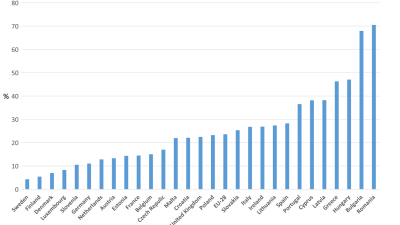On 18 July, Louise Casey, head of the Troubled Families Programme, published a report called Listening to Troubled Families. It presents sixteen case studies of families participating in Family Intervention Projects, claiming that this is ‘a good starting place to inform our thinking and policy development’. Well, no it isn’t. This is policy-making by anecdote, more akin to tabloid journalism than serious research. Casey’s group is not representative of those targeted by the TFP, and it is certainly not representative of the multiply deprived families who make up the so-called 120,000 troubled families. This pseudo-research serves only to present the poor as dysfunctional, both as individuals and as families.
Eight of the sixteen families in the ‘case studies’ had four or more children. Seven had five or more, while two families had nine and twelve children respectively. Casey compares this with a figure of 4 per cent of all families having four or more children. Listening to Troubled Families presents the problem as one of large families by multiple partners forming a burgeoning dysfunctional underclass resistant to reform: ‘Many have large families and keep having children, often with different fathers, even if they are struggling to cope with the children they already have’. A Guardian interview quotes her:
It’s not just that you are a family and your kids are antisocial, and it’s not just that you started having five to 10 children from the age of 16. It’s every single problem going … they are responsible for a good number of them and some of [the families] feel they don’t need help from anyone.
The report itself presents a picture of the intergenerational transmission of violence, sexual abuse and substance abuse. Casey summarises thus:
The most striking common theme that families described was the history of sexual and physical abuse, often going back generations; the involvement of the care system in the lives of both parents and their children, parents having children very young, those parents being involved in violent relationships, and the children going on to have behavioural problems, leading to exclusion from school, anti-social behaviour and crime. … Violence appears in many cases to be endemic – not just domestic violence between parents but violence between siblings, between parent and child, outside the house and inside the house. Violence, verbal and physical abuse was described in an almost matter-of-fact way. Unexpectedly, arson was cited in a significant proportion of families, as either evidence of the children having problems or with regard to their homes being destroyed.
Let us reiterate what we know about the 117,000 families with multiple problems as we first set out in the PSE working paper, There may be ‘trouble’ ahead: what we know about those 120,000 ‘troubled’ families. Leaving on one side the unreliability of the original estimate, these are families with five of the following seven characteristics:
No parent in the family is in work;
Family lives in overcrowded housing;
No parent has any qualifications;
Mother has mental health problems;
At least one parent has a long-standing limiting illness, disability or infirmity;
Family has low income (below 60% of median income);
Family cannot afford a number of food and clothing items.
Are those multiply-deprived families particularly likely to have loads of children? Not as far as we know. Reaching Out: Think Family one of the background reports from the Families at Risk Review on these ‘117,000’ multiply-deprived families said the sample was too small to demonstrate any difference from the population as a whole.
Are the children overwhelmingly likely to be involved in crime and anti-social behaviour or be excluded from school? No. According to Reaching Out: Think Family, they were more likely to have ‘had contact with the police’ (which could be as a victim as much as a perpetrator) or to have been excluded from school. But despite that increased risk, 90 per cent of the children in these very deprived families had had no contact with the police; and nearly 90 per cent had not been excluded from school.
Doubtless families with backgrounds and circumstances as difficult as Casey documents exist – although there might be quite other ways of telling their stories than in the narratives presented here. There are sixteen of them. They are at best (or worst) a tiny minority of those suffering severe and multiple deprivation, a tiny minority of those children living in poverty and those families struggling with the consequences of recurrent poverty and increasing austerity.



 PSE:UK is a major collaboration between the University of Bristol, Heriot-Watt University, The Open University, Queen's University Belfast, University of Glasgow and the University of York working with the National Centre for Social Research and the Northern Ireland Statistics and Research Agency. ESRC Grant RES-060-25-0052.
PSE:UK is a major collaboration between the University of Bristol, Heriot-Watt University, The Open University, Queen's University Belfast, University of Glasgow and the University of York working with the National Centre for Social Research and the Northern Ireland Statistics and Research Agency. ESRC Grant RES-060-25-0052.






